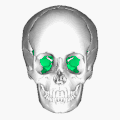| Sphenoid bone | |
|---|---|
 Position of the sphenoid bone | |
 Animation of the sphenoid bone | |
| Details | |
| Identifiers | |
| Latin | os sphenoidale |
| MeSH | D013100 |
| TA98 | A02.1.05.001 |
| TA2 | 584 |
| FMA | 52736 |
| Anatomical terms of bone | |
The sphenoid bone [note 1] is an unpaired bone of the neurocranium. It is situated in the middle of the skull towards the front, in front of the basilar part of the occipital bone. The sphenoid bone is one of the seven bones that articulate to form the orbit. Its shape somewhat resembles that of a butterfly, bat or wasp with its wings extended. The name presumably originates from this shape, since sphekodes (σφηκώδης) means 'wasp-like' in Ancient Greek.
Contents
- Structure
- Intrinsic ligaments of the sphenoid
- Features
- Articulations
- Body of sphenoid
- Superior or cerebral surface
- Inferior surface
- Anterior surface
- Posterior surface
- Lateral surface
- Sphenoidal sinuses
- Greater wings
- Superior or cerebral surface 2
- Lateral surface 2
- Orbital surface
- Lesser wings
- Development
- Function
- Other animals
- Additional images
- See also
- Notes
- References
- External links

















